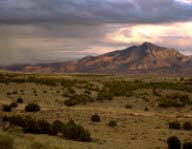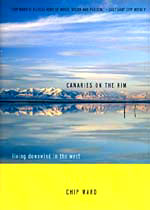
This is the place.
Photo: BLM.
With its red rock canyons, snow covered peaks, alkali plains, slickrock, and Great Salt Lake, the varied terrain of Utah forms strikingly beautiful landscapes. This arresting scenery drew Chip Ward and family to the state in the 1970s, and persuaded them to settle in the seemingly placid town of Grantsville on the edge of Utah’s West Desert.
The West Desert, like much of the Great Basin, with its vast sagebrush hills, dry soils, rocky outcrops, and subtle coloring, has prompted both early and modern-day settlers to ask, “What is it good for?” In the 20th century, that question has been answered by boom-and-bust cycles of mining as well as an influx of military installations and hazardous industries that more densely populated regions would never tolerate.
Canaries on the Rim is Ward’s account of a community’s evolution into activism as it began to investigate the lethal legacy of its landscape’s use and abuse. Ward recounts the terrifying nonchalance with which Utah’s residents greeted early atomic tests and their apparently unquestioning acceptance of chemical plants and military operations that exposed them to dangerous materials. In the 1980s, alarmed at the prospect of sharing their backyards with the MX missile system and new toxic waste incinerators, some of the locals started to organize.
Confronting a disconcerting frequency of debilitating and deadly illnesses, Ward and his neighbors began to gather around kitchen tables to formulate a measured and direct approach to tackling the problem — a problem involving government and corporate secrecy and what seemed to be a willingness to exploit the health of residents of the rural desert. Together, in a real grassroots effort, the community and others who joined with them persuaded the U.S. Army to alter some of its munitions disposal practices and initiated a difficult but successful campaign to clean up the operations of a local chemical plant.
An understanding of how the desert works and the inextricable connection between environmental and human health is at the root of Ward’s activism. His is not a story of a single short-lived environmental battle, but of an ongoing struggle to right the wrongs that have been inflicted on that country and its people.

Mellow yellow — sunset over
the West Desert.
Photo: BLM.
“We are the newcomers here,” he writes, “with our big thirsty cows, our broad highways and fast cars, our glittering casinos and horrific doomsday weapons, our booming jets and electronic battlefields, our war labs and bottomless toxic waste. When we gaze through the shimmering heat at the desert’s vastness and proclaim it is an ’empty wasteland,’ we are condemning it for craven use.”
Ward is far from the first to bring the story of Utah’s downwinders and the destructive power of toxic waste to public attention, but this problem is not going away. Hazardous waste incinerators and buried toxics seeping into aquifers confront communities throughout the Great Basin and rural West. Outspoken, succinct, and very personal, Canaries on the Rim presents another disturbing portrait of how America has poisoned one of its most fragile landscapes — and makes a strong call for understanding and restorative action.



